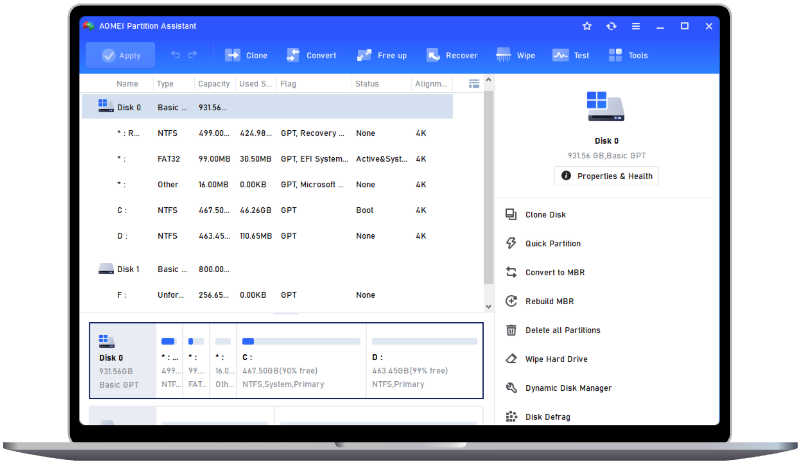How to Extend Partition with Non Contiguous Space on Windows 10
What if Windows 10 extend partition non contiguous not working? Read this post to get the easiest way to extend partition with non contiguous space in Windows 10 as well as learn two built-in tools to make it.
Can’t merge non-contiguous partition on Windows 10
“I just extended the disk from 60 GB to 80GB. Now I'm trying to figure out how to add that space to my C: drive. The option to "Extend Volume..." is grayed out because there's a "Healthy (Recovery Partition)" between my C: partition and the new unallocated space. Is there any way to add this new space to the C: drive?” – Superuser Forum
When there is unallocated space next to the partition you wish to expand, the "Extend Volume" feature can be used to increase its size. However, real-world scenarios often present more challenges. In many cases, there’s no unallocated space available, or the partitions are not adjacent to each other. As a result, the "Extend Volume" option may be grayed out.
In simple terms, the availability of the "Extend Volume" function depends on whether unallocated space exists between two non-adjacent partitions. For example, as shown in the table, you can merge the C drive with the unallocated space, but you cannot directly extend the D or E drives since the unallocated space is not right behind them. That’s why so many Windows users complain the operation of “Windows 10 extend partition non contiguous” fails.
|
C drive |
Unallocated space |
D drive |
E drive |
Easily extend partition with non contiguous space in Windows 10 with partition manager
AOMEI Partition Assistant is a powerful third-party partition management tool designed to address the needs of Windows users. Fully compatible with all versions of Windows, it offers a wide range of disk management features. Key functions that set it apart include "Migrate OS", "Resize/MovePartition", "WipePartition", "Clone Partition", and the ability to "Convert between MBR/GPT or Basic/Dynamic".
One standout feature is the "1-Click Adjust Space" feature, which enables you to extend or shrink a partition space by simply dragging the dots next to the partitions' head and tail, which means you can resize multiple partitions at the same time. That’s why you can extend partition with non contiguous space in Windows 10 with this software.
For those looking to extend volume non contiguous, AOMEI Partition Assistant offers a simple solution. Regardless of the situation, this software can handle all common scenarios. Simply download and install it on your computer, and we'll provide detailed instructions for each step.
Step 1. Install and launch AOMEI Partition Assistant. Right-click a partition (here is D: partition) you want to adjust space and select "1-Click Adjust Space".
Step 2. If you want to use the space on F: to expand D:, you can simply drag the dot near the partition F: head backward to shrink the partition F: and enlarge the partition D: at the same time. Then click "OK".
Tips: You can simultaneously drag the dot near the partition C: tail forward to shrink the partition C: so the D: will also be enlarged with the space of C: at the same time. In this case, you can adjust all partition space (C:, D:, and F:) on the disk.
Step 3. You can preview the operation by viewing the "Pending Operations". To commit the "Pending Operations", please click "Apply" and "Proceed".
Step 4. The process will start and you can check the progress. It might take time to finish the operation.
Step 5. Wait for the operation to be finished. After it is completed successfully, you will find D: is enlarged and both D: and F: are adjusted.
✍ Note: AOMEI Partition Assistant also has a feature called “Merge Partition” which can easily combine a partition with the unallocated space in a few clicks, no matter whether the unallocated space is or is not adjacent.
2 other ways to make Windows 10 extend partition non contiguous space
If you don’t want to download third-party software, you can continue using Windows built-in tools. Two common Windows native utilities will be introduced in this part.
1. Disk Management
Disk Management is a built-in tool in Windows for managing partitions. However, it's important to note that Disk Management can only extend NTFS or RAW partitions that are directly followed by unallocated space.
So, if the partitions are non-adjacent, even if there is unallocated space between them, you must delete the intervening partition to convert it into unallocated space next to the first partition before you can extend it. Here is the step-by-step guide:
Note: Deleting the interrupting partition is a permanent action. The files on it can only be recovered with professional data recovery software. Make sure to back up any important files stored on it before proceeding.
Step 1. Press Windows + X and select Disk Management.
Step 2. Find the partition next to the D drive that’s taking up the space (Here take D drive as an example).
Step 3. Right-click the partition and choose Delete Volume.
There will be a pop-up window, which will notify you that this operation will erase all the data on the selected drive, and select “YES”. This will remove the partition and turn it into unallocated space.
Step 4. Now that the unallocated space is next to the C drive, right-click the C drive and select Extend Volume.
Step 5. Complete the wizard to extend the C drive using the unallocated space.
2. DiskPart
Diskpart, another built-in Windows disk management tool, shares similar limitations with Disk Management when it comes to merging partitions. In this case, we’ll walk through how to extend C drive with non-adjacent unallocated space using Diskpart.
Step 1. Press Windows + R to open the Run dialog.
Step 2. Type diskpart and hit Enter. If prompted, allow Diskpart to run as an administrator.
Step 3. In the Diskpart window, type list disk and press Enter. This will display all disks on your system.
Step 4. Identify the disk containing your C drive and type select disk X (replace X with the disk number).
Step 5. Type list partition to display all partitions on the selected disk.
Step 6. Identify the partition separating the C drive and the unallocated space.
Step 7. Type select partition Y (replace Y with the partition number).
Step 8. Type delete partition and press Enter. This action deletes the interrupting partition, making the unallocated space adjacent to the C drive.
Step 9. Type select partition Z (replace Z with the C drive's partition number).
Step 10. Type extend and press Enter. Diskpart will use the adjacent unallocated space to extend the C drive.
Step 11. Type list partition again to confirm the C drive has been extended.
Step 12. Exit Diskpart by typing exit.
Conclusion
In summary, it’s hard for Windows 10 extend partition non contiguous with native tools like Disk Management and DiskPart which can only extend partitions when unallocated space directly follows them. For a more efficient and risk-free solution, AOMEI Partition Assistant offers advanced features, including "1-Click Adjust Space", allowing users to extend partitions with non-contiguous space without the need for partition deletion.
Moreover, it also comes with some other useful features to increase space in C drive to solve the “C drive is full” error like moving files from C drive to D drive, cleaning up disk space, deleting large files, etc.


